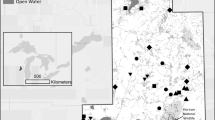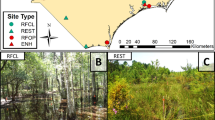Abstract
Nebraska’s Rainwater Basin has an abundance of natural wetlands and is a focal point in the annual migration corridor used by millions of waterfowl and shorebirds. However, these wetlands are in a landscape dominated by agriculture and as a result, siltation and poor water quality are continual problems. We evaluated twelve wetland sites on federally managed Waterfowl Protection Areas from 2007 – 2009 for water quality, sediment quality, and macroinvertebrate diversity. Six of the sites received agricultural runoff directly via culverts and drainage ditches (non-buffered sites) and six sites were protected from agricultural runoff by a vegetated buffer (buffered sites). Mean total number of aquatic macroinvertebrates were significantly greater (p <0.001) for buffered sites (230 ± 44 standard error) than non-buffered sites (97 ± 24). Water from non-buffered sites had significantly greater turbidity, conductivity, and concentrations of chlorophyll α and atrazine than buffered sites in addition to consistently greater annual averages of total nitrogen and total phosphorus. Furthermore, sediments from non-buffered sites had significantly greater cadmium, potassium, sodium and zinc than buffered sites. Use of vegetative buffers to intercept direct row-crop runoff can improve water quality and aquatic macroinvertebrate diversity and abundance in Rainwater Basin wetlands.

Similar content being viewed by others
References
Adamus PR (1996) Bioindicators for assessing ecological integrity of prairie wetlands. U.S. Environmental Protection Agency, Corvalis
Anderson TD, Zhu KY (2004) Synergistic and antagonistic effects of atrazine on the toxicity of organophosphorodithioate and organophosphorothioate insecticides to Chironomus tentans (Diptera: Chironomidae). Pesticide Biochemistry and Physiology 80:54–64
Batzer DP, Rader RB, Wissinger SA (1999) Invertebrates in freshwater wetlands of North America: ecology and management. John Wiley and Sons, Incorporated, New York
Belden JB, Hanson BR, McMurry ST, Smith LM, Haukos DA (2012) Assessment of the effects of farming and conservation programs on pesticide deposition in high plains wetlands. Environmental Science and Technology 46:3424–3432
Bishop A, Walters R, Drahota J (2004) Rainwater Basin wetland complex vegetation mapping and monitoring project, final report. Rainwater Basin Joint Venture, U.S. Fish and Wildlife Service, Nebraska Game and Parks Commission and U.S. Fish and Wildlife Service, Nebraska Game and Parks Commission and U.S. Bureau of Reclamation, Grand Island
Borgmann U, Norwood WP, Babirad IM (1991) Relationship between chronic toxicity and bioaccumulation of cadmium in Hyalella azteca. Canadian Journal of Fisheries and Aquatic Sciences 48:1055–1060
Buchman MF (2008) Screening quick reference tables, NOAA OR&R report 08-1. Office of Response and Restoration Division, National Oceanic and Atmospheric Administration. Seattle, WA. http://response.restoration.noaa.gov/book_shelf/12. Accessed 15 Mar 2010
Burkholder J, Libra B, Weyer P (2007) Impacts on waste from concentrated animal feeding operations on water quality. Environmental Health Perspectives 115(2):308–312
Canadian Council of Ministries of the Environment (CCME) (1999) Canadian water quality guidelines for the protection of aquatic life: glyphosate. In: Canadian Council of Ministries of the Environment, Canadian Environmental Quality Guidelines, 1999. A Canadian Council of Ministries of the Environment Report. Winnipeg, Manitoba
Canadian Council of Ministries of the Environment (CCME) (2002) Canadian sediment quality guidelines for the protection of aquatic life: Summary tables. Updated. In: Canadian environmental quality guidelines, 1999. Canadian Council of Ministers of the Environment, Winnipeg
Davis CA, Bidwell JR (2008) Response of aquatic invertebrates to vegetation management and agriculture. Wetlands 28(3):793–805
Dewey SL (1986) Effects of the herbicide atrazine on aquatic insect community structure and emergence. Ecology 67:148–162
Douglas GM (2001) Pennak’s freshwater invertebrates of the United States: prorifera to crustacean. John Wiley and Sons Publishing Company, Hoboken
Eisler R (1985) Cadmium hazards to fish, wildlife, and invertebrates: a synoptic review. U.S. Fish and Wildlife Service Biological Report 85(1.20) Report #2. 30 pp. http://www.pwrc.usgs.gov/infobase/eisler/reviews.cfm. Accessed 2 Apr 2010
Eisler R (1989) Molybdenum hazards to fish, wildlife, and invertebrates: a synoptic review. U.S. Fish and Wildlife Service Biological Report 85(1.19) Report #19. 43 pp. http://www.pwrc.usgs.gov/infobase/eisler/reviews.cfm. Accessed 15 Mar 2010
Euliss NH, Mushet DM (1999) Influence of agriculture on aquatic invertebrate communities of temporary wetlands in the Prairie Pothole Region of North Dakota, USA. Wetlands 19:578–583
Gordon CC, Flake LD, Higgins KF (1990) Aquatic invertebrates in the rainwater basin area of Nebraska. The Prairie Naturalist 23(3):191–200
Gordon CC, Flake LD, Higgins KF (1997) Trace metals in water and sediments of wetlands in the Rainwater Basin area of Nebraska. Proceedings of the South Dakota Academy of Sciences 72:253–261
Grue CE, DeWeese LR, Mineau P, Swanson GA, Foster JR, Arnold PM, Huckins JN, Sheehan PJ, Marshall WK, Ludden AP (1986) Potential impacts of agricultural chemicals on waterfowl and other wildlife inhabiting prairie wetlands: an evaluation of research needs and approaches. Transactions of the North American Wildlife and Natural Resources Conference 51:357–383
Haycock NE, Burt TP (1991) The sensitivity of rivers to nitrate leaching: the effectiveness of near-stream land as a nutrient retention zone. In: Allison RJ, Thomas DS (eds) Landscape Sensitivity. Wiley, London, pp 312–319
Hayes TB, Khoury V, Narayana A, Nazir M, Park A, Brown T, Adame L, Chan E, Buchholz D, Stueve T, Gallipeau S (2010) Atrazine induces complete feminization and chemical castration in male African clawed frogs (Xenopus laevis). Proceedings of the National Academy of Sciences 107:4612–4617
Hemesath LM (1991) Species richness and nest productivity of marsh birds on restored prairie potholes in norther Iowa. M.S. Thesis, Iowa State University, Ames, IA
Hentges VA, Stewart TW (2010) Macroinvertebrate assemblages in Iowa Prairie pothole wetlands and relation to environmental features. Wetlands 30:501–511
Jin-Clark Y, Lydy MJ, Zhu KY (2002) Effects of atrazine and cyanazine on chloropyrifos toxicity in Chironomus tentans (Diptera: Chironomidae). Environmental Toxicology and Chemistry 21(3):598–603
LaGrange T (2005) Guide to Nebraska’s Wetlands and their conservation needs. Nebraska Game and Parks Commission. Lincoln, Nebraska. http://outdoornebraska.ne.gov/conservation.asp. Accessed 13 Aug 2009
Levy S (1998) Using bugs to bust polluters. BioScience 48(5):342–346
MacDonald DD, Ingersoll CG, Berger TA (2000) Development and evaluation of consensus-based sediment quality guidelines for freshwater ecosystems. Archives of Environmental Contamination and Toxicology 39:20–31
Mackie G (2004) Applied aquatic ecosystem concepts. Kendal/Hunt Publishing Company, Dubuque
Merritt RW, Cummins KW, Berg MB (2008) An introduction to the aquatic insects of North America. Kendall/Hunt Publishing Company, Dubuque
Mitsch WJ, Gosselink JG (2000) Wetlands, 3rd edn. John Wiley and Sons, Incorporated, New York
Muscutt AD, Harris GL, Bailey SW, Davies DB (1993) Buffer zones to improve water quality: a review of their potential use in UK agriculture. Agricultural Ecosystem Environment 45:59–77
Narumalani S, Zhou Y, Jensen JR (1997) Application of remote sensing and geographic information systems to the delineation and analysis of riparian buffer zones. Aquatic Botany 58:393–409
National Agricultural Statistics Service (NASS) (2010) Agricultural chemical usage reports. http://www.nass.usda.gov/statistics_by_subject/environmental/index.asp. Accessed 20 Jun 2011
Nebraska Department of Environmental Quality (NDEQ) (2009) Title 117 Nebraska water quality standards. http://www.deq.state.ne.us/. Accessed 3 Jan 2011
Nelson SM, Roline RA, Thullen JS, Sartoris JJ, Boutwell JE (2000) Invertebrate assemblages and trace element bioaccumulation associated with constructed wetlands. Wetlands 20(2):406–415
Osborne LL, Kovacic DA (1993) Riparian vegetated buffer strips in water quality restoration and stream management. Freshwater Biology 29(2):243–258
Papoulias MS, Schwarz M, Lourdes M (2012) Gonadal abnormalities in frogs (Lithobates spp.) collected from managed wetlands in an agricultural region of Nebraska, USA. Environmental Pollution 172:1–8
Pederson RL, Jorde DG, Simpson SG (1989) Northern great plains. In: Smith LM, Pederson RL, Kaminski RM (eds) Habitat management for migrating and wintering waterfowl in North America. Texas Tech University Press, Lubbock, pp 281–310
Peterjohn WT, Correll DL (1984) Nutrient dynamics in an agricultural watershed: observations on the role of a riparian forest. Ecology 65:1466–1475
Putwattana N, Kruatrachue M, Pokethitiyook P, Chaiyarat R (2010) Immobilization of cadmium in soil by cow manure and silicate fertilizer, and reduced accumulation of cadmium in sweet basil (Ocimum basilicum). ScienceAsia 36:349–354
Resh VH, Meyers MJ, Hannaford MJ (1996) Macroinvertebrates as biotic indicators of environmental quality. In: Hauer FR, Lamberti GA (eds) Methods in stream ecology. Academic, San Diego, pp 647–667
SAS Institute (2012) Version 9.3. SAS Institute, Cary
Schildman G, Hurt J (1984) Update of the rainwater basin wetland survey. Survey of the habitat work plan K-83, Pittman-Robertson Project W-15-R-40. Nebraska Game and Parks Commission, Lincoln
Schulz R (2004) Field studies on exposure, effects, and risk mitigation of aquatic non-source insecticide pollution: a review. Journal of Environmental Quality 33:419–448
Schwarz MS, Echols KR, Wolcott MJ, Nelson KJ (2004) Environmental contaminants associated with swine concentrated animal feeding operation and implications for McMurtrey National Wildlife Refuge. US Fish and Wildlife Service Contaminant Report, Grand Island
Sewell RW, Higgins KF (1991) Floral and faunal colonization of restored wetlands in west-central Minnesota and northeastern South Dakota. Proceeding of the 18th annual conference on wetland restoration and creation. Hillsborough College, Tamapa
Shacklette HT, Boerngen JG (1984) Element concentrations in soils and other surficial materials of the conterminous United States. Professional paper 1270. U.S. Geological Survey, Washington D.C.
Sims TJ (1995) Characteristics of animal wastes and waste-amended soils: an overview of the agricultural and environmental issues. In: Steel K (ed) Animal Waste and the Land-water Interface. Lewis Publishers, Boca Raton
Smith LM (1998) Research needs for the rainwater basin of Nebraska: a hierarchical approach. Rainwater Basin Joint Venture, Grand Island. http://www.rwbjv.org. Accessed 27 Nov 2009
Spieles DJ, Mitsch WJ (2000) Macroinvertebrate community structure in high- and low-nutrient constructed wetlands. Wetlands 20(4):716–729
Stanley JK, Brooks BW, La Point TW (2005) A comparison of chronic cadmium effects on Hyalella Azteca in effluent-dominated stream mesocosms to similar laboratory exposures in effluent and reconstituted hard water. Environmental Toxicology and Chemistry 24(4):902–908
Steinman AD, Conklin J, Bohlen PJ (2003) Influence of cattle grazing and pasture land use on macroinvertebrate communities in freshwater wetlands. Wetlands 23(4):877–889
Turner AM, Trexler JC (1997) Sampling aquatic invertebrates from marshes: evaluating the options. Journal of the North American Benthological Society 16(3):694–709
U.S. Department of Agriculture (USDA) (1991) Riparian forest buffers: function and design for protection and enhancement of water resources. USDA Forest Service, Forest Resources Management, Radnor
U.S. Department of the Interior (USDOI) (1998) Guidelines for the interpretation of the biological effects of selected constituents in biota, water, and sediment. National Irrigation Water Quality Program Information Report No.3. U.S. Department of the Interior, Denver
U.S. Environmental Protection Agency (EPA) (2001) Environmental assessment of proposed revisions to the national pollutant discharge elimination system regulation and the effluent guidelines for concentrated animal feeding operations, EPA-821-B-01-001. http://www.epa.gov/ost/guide/cafo/envir.html. Accessed 15 Mar 2010
U.S. Fish and Wildlife Service (Service) (2007) Comprehensive conservation plan. Rainwater Basin Wetland Management District. Kearney http://www.fws.gov/mountain-prairie/planning/ccp/ne/rwb.html. Accessed 27 Nov 2009
U.S. Fish and Wildlife Service (Service) (2009) An evaluation of agricultural chemical exposure and effects to wildlife on Waterfowl Production Areas in the Rainwater Basin Wetland Management District. U.S. Fish and Wildlife Service Raw Data, Grand Island
Van Dam RA, Camilleri C, Finlayson CM (1998) The potential of rapid assessment techniques as early warning indicators of wetland. Environmental Toxicology and Water Quality 13(4):297–312
Voshell JR (2005) A guide to common freshwater invertebrates of North America. Mcdonald and Woodward Publishing Company, Blacksburg
Williams DD (1996) Environmental constraints in temporary fresh waters, and their consequences for insect fauna. Journal of the North American Benthological Society 15:634–650
Williams DD (2006) The biology of temporary waters. Oxford University Press, New York
Acknowledgments
Funding for this research was provided by the U.S. Fish and Wildlife Service, On-Refuge Environmental Contaminants fund and the University of Nebraska at Kearney Research Services Council. The findings and conclusions in this article are those of the authors and do not necessarily represent the views of the U.S. Fish and Wildlife Service. The authors would like to thank the following for their assistance with this research: Joseph DeCant, Lourdes Mena, LaNae Hays, Jeff Drahota, Nadeeshani Jayasena, David Marx, Kerri Farnsworth-Hoback, Keith Koupal, Roger Grosse, Drew Prososki, Kathy Maline, Jason Gfeller, and Nancy Riens. Thanks to Ward Laboratories for discounted analytical services.
Author information
Authors and Affiliations
Corresponding author
Additional information
The information stated in this article has not been published elsewhere.
Rights and permissions
About this article
Cite this article
Riens, J.R., Schwarz, M.S., Mustafa, F. et al. Aquatic Macroinvertebrate Communities and Water Quality at Buffered and Non-Buffered Wetland Sites on Federal Waterfowl Production Areas in the Rainwater Basin, Nebraska. Wetlands 33, 1025–1036 (2013). https://doi.org/10.1007/s13157-013-0460-7
Received:
Accepted:
Published:
Issue Date:
DOI: https://doi.org/10.1007/s13157-013-0460-7




